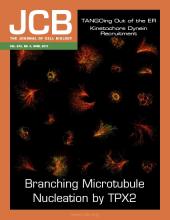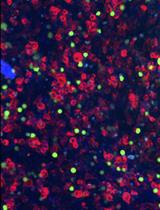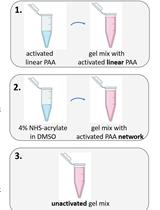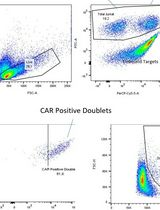- EN - English
- CN - 中文
Using xCELLigence RTCA Instrument to Measure Cell Adhesion
使用xCELLigence RTCA仪器测量细胞粘附
(*contributed equally to this work) 发布: 2017年12月20日第7卷第24期 DOI: 10.21769/BioProtoc.2646 浏览次数: 15078
评审: Pengpeng LiSavita NairAnonymous reviewer(s)
Abstract
Cell adhesion to neighbouring cells and to the underlying extracellular matrix (ECM) is a fundamental requirement for the existence of multicellular organisms. As such, the formation, stability and dissociation of cell adhesions are subject to tight control in space and time and perturbations within the sophisticated adhesion machinery are associated with a variety of human pathologies. Here, we outline a simple protocol to monitor alterations in cell adhesion to the ECM, for example, following genetic manipulations or overexpression of a protein of interest or in response to drug treatment, using the xCELLigence real-time cell analysis (RTCA) system.
Keywords: xCELLigence (xCELLigence)Background
The principal molecules responsible for cell adhesion to the underlying ECM are a family of transmembrane heterodimeric receptors named integrins. Integrin activation and binding to the ECM triggers the recruitment of a vast array of signalling, scaffolding and cytoskeletal proteins to the integrin cytoplasmic tails. Together, these adhesion constituents represent a complex and highly dynamic machinery responsible for regulating many important cellular processes including cell proliferation, survival, migration and differentiation. In line with significant roles in maintaining normal physiological functions, dysregulated integrin-mediated adhesion and signalling is a forerunner in the pathogenesis of many human ailments, including bleeding disorders, cardiovascular disease and cancer (Giancotti and Ruoslahti, 1999; Bökel and Brown, 2002; Huveneers and Danen, 2009; Legate et al., 2009; Bouvard et al., 2013; Calderwood et al., 2013; Horton et al., 2015; Seguin et al., 2015). Therefore, investigation of integrin-dependent cell-ECM adhesions is an intensely studied research topic and of broad interest to many biological fields.
In addition to a variety of other techniques, we (Georgiadou et al., 2017; Lilja et al., 2017; Närvä et al., 2017) and others (Kiely et al., 2015; Böhm et al., 2016; Salmela et al., 2016) have used the xCELLigence RTCA system as a simple, yet quantitative, method to monitor changes in cell-ECM adhesion. This technology works by measuring electron flow transmitted between gold microelectrodes, fused to the bottom surface of a microtiter plate, in the presence of an electrically conductive solution such as tissue culture medium (Figure 1). Adhering cells disrupt the interaction between the electrodes and the bulk solution and thus impede electron flow. This impedance (resistance to alternating current) is expressed as arbitrary units called cell index (Figure 1), the magnitude of which is dependent on cell number, cell morphology and cell size and on the strength of cell attachment to the substrate coating the plate. The advantage of using xCELLigence RTCA, as opposed to traditional dye- or microscopy-based analysis of cell adhesion (Chen et al., 2009; Humphries, 2009; Humphries et al., 2009; Chen, 2012), is that a continuous readout, rather than a single time-point or end-point analysis, of cell adhesion can be obtained from the moment the cells begin to attach to the substrate. Moreover, measurements are based on the whole cell population rather than individually selected cells and therefore results are less likely to be subject to bias. However, there are situations where analysing adhesion based on a cell population is flawed. For example, when the effects of protein overexpression or knockdown are being investigated and the transfection efficiency is extremely low, the xCELLigence system will not provide a true reflection of the experimental manipulation on cell adhesion. Indeed, in these cases microscopy based imaging of known adhesion components, to monitor changes in the size and/or morphology of cell-ECM contacts, and the actin cytoskeleton, to monitor cell size and cell spreading, in individual transfected cells would be a more suitable approach. Nevertheless, the inclusion of a 96-well E-plate format within the xCELLigence RTCA single plate (SP) model enables testing of multiple experimental conditions at the same time and in the same plate, thus reducing experimental variability and allowing quick deduction of optimal assay parameters (e.g., ECM ligand concentration or time-point/s of adhesion) for more comprehensive analyses that may require more costly reagents and additional optimisation.
We have in the past used xCELLigence RTCA to analyse cell adhesion in MDA-MB-231 (triple-negative human breast adenocarcinoma) cells and HEK293 (human embryonic kidney) cells (Lilja et al., 2017), in MEFs (mouse embryonic fibroblasts) (Georgiadou et al., 2017) and in human iPSCs (induced pluripotent stem cells) (Närvä et al., 2017). We found that loss of the metabolic regulator AMPK (Georgiadou et al., 2017) or the postsynaptic density scaffolding protein Shank (Lilja et al., 2017) promotes cell adhesion to ECM molecules over time, supporting a role for these two proteins as novel inhibitors of integrin function. We have also used xCELLigence to demonstrate the different adhesive properties of human iPSCs following differentiation (Närvä et al., 2017). Here, we will describe the xCELLigence RTCA cell adhesion protocol for HEK293 cells (Lilja et al., 2017) and indicate, where appropriate, the optimisation steps required for other cell types. 
Figure 1. Using the xCELLigence RTCA system to monitor cell adhesion. A. A simplified cartoon of an E-plate 96 and the gold microelectrodes embedded within each well (top view of a single well) is shown on the left. The number and size of the gold microelectrodes are not representative of the actual set-up and are for illustrative purposes only. The E-plate 96 is placed within the RTCA SP Station (1), which is kept in a humidified incubator and is connected to the RTCA Analyzer (2) and RTCA Control Unit (3). B. Workflow of an xCELLigence adhesion assay. Here, the example assay sets out to determine the optimal concentration of two different ECM ligands (purple and green) needed to promote efficient cell adhesion and to be used for further analyses. 1. The wells in the E-plate 96 are coated with serial dilutions of the ECM ligands or with BSA (yellow) as a negative control. All conditions are performed in triplicate. 2. Coating solutions are removed, wells are washed with PBS and blocked with 0.1% BSA (yellow tube) to prevent non-specific cell adhesion and then incubated with the base medium (pink) that is specific for the cell line of interest. 3. The plate is then placed in the RTCA SP station in the incubator and a reading is taken. Here, a side view of a single well in the E-plate demonstrates unimpeded electron flow from the negative to the positive terminal in the presence of medium alone, which results in a low background reading. 4. Cells are then added to the coated wells (Note: Some wells can be kept cell-free (medium-only wells) as another negative control that should only give background readings). 5. The plate is then placed back into the xCELLigence system and cell adhesion is monitored over time. Here, a side view of a single well in the E-plate demonstrates impeded electron flow from the negative to the positive terminal in the presence of adhering cells, which results in increasing impedance over time as more cells adhere and spread on the microelectrodes. *Impedance in electron flow (resistance to an alternating current) is plotted as arbitrary units called cell index. Background readings: obtained from medium alone (pink line) or from BSA-coated (yellow line) wells. Experimental readings: for simplicity, cell adhesion is shown for one of the ECM ligands (dark to light purple; high to low concentration of ligand) and for one technical replicate only. In this graphical illustration, two concentrations of the ECM ligand resulted in overlapping curves and similarly high cell index values. Therefore, the lower of these two concentrations could be used in subsequent experiments to preserve on material and reduce costs.
Materials and Reagents
- Pipette tips
- Tissue culture treated dishes (CELLSTAR® 100 x 20 mm, Greiner Bio One International, catalog number: 664160 ; 6-well, Greiner Bio One International, catalog number: 657160 ; 96-well, Greiner Bio One International, catalog number: 655160 )
- Falcon 15-ml conical centrifuge tubes (Corning, Falcon®, catalog number: 352196 )
- Falcon 50-ml conical centrifuge tubes (Corning, Falcon®, catalog number: 352070 )
- Microcentrifuge tubes, 1.5 ml (SARSTEDT, catalog number: 72.690.001 )
- Minisart® 0.45 µm single-use filters (Sartorius, catalog number: 16537-K )
- 60 ml syringes (BD, catalog number: 300866 )
- 96-well E-plates (E-plate 96) (ACEA Bio, catalog number: 5232368001 )
- Cell line of interest, e.g., HEK293 cells (ATCC, catalog number: CRL-1573 )
- Phosphate buffered saline (PBS) (Sigma-Aldrich, catalog number: D1408 )
- ECM molecule of choice e.g., fibronectin (bovine plasma) (Sigma-Aldrich, catalog number: 341631 ); collagen (collagen from calf skin) (Sigma-Aldrich, catalog number: C8919 )
- HyCloneTM HyQTase cell detachment reagent (GE Healthcare, HyCloneTM, catalog number: SV30030.01 )
- Dulbecco’s modified Eagle’s medium (DMEM) with high glucose (4,500 mg/L) (Sigma-Aldrich, catalog number: D5671 )
- L-Glutamine (Thermo Fisher Scientific, GibcoTM, catalog number: 25030149 )
- Fetal bovine serum (FBS) (Sigma-Aldrich, catalog number: F7524 )
- Trypsin-EDTA for cell culture (Sigma-Aldrich, catalog number: T4049 )
- ≥ 96% pure bovine serum albumin (BSA) (Sigma-Aldrich, catalog number: A8022 )
- Appropriate growth medium for culturing cell line of interest (see Recipes)
- Appropriate base medium to be used in experiment (see Recipes)
- Fibronectin-collagen mix (see Recipes)
- 0.1% BSA (see Recipes)
Equipment
- Adjustable-volume pipettes (e.g., Fisher Scientific, model: FisherbrandTM EliteTM )
- Water bath
- Multichannel pipettes (e.g., Fisher Scientific, model: FisherbrandTM EliteTM )
- 37 °C, 5% CO2 water jacketed incubator (e.g., Thermo Fisher Scientific, Thermo ScientificTM, model: Series 8000 Water-Jacketed CO2 Incubators )
- Cell culture laminar hood (e.g., NuAire CellGardTM)
- Tabletop centrifuge for 15 ml and 50 ml conical tubes (e.g., Eppendorf, model: 5804 )
- Bürker cell-counting chamber (e.g., BRAND, catalog number: 719520 )
- Bright-field microscope (e.g., Olympus, model: CKX41 or ZEISS Axio Vert)
- xCELLigence RTCA SP Instrument (ACEA Bio, catalog number for complete system: 00380601030 ) which consists of:
- RTCA Analyzer (ACEA Bio, model W830, catalog number: 05228972001 )–an electronic analyser that measures, processes and analyses the impedance detected by sensor electrodes
- RTCA SP Station (ACEA Bio, catalog number: 05229057001 )–E-plate holder that is placed inside the incubator and connects the E-plate to the RTCA Analyzer
- RTCA Control Unit (ACEA Bio, catalog number: 05454417001 )–laptop with pre-installed RTCA Software
- RTCA Analyzer (ACEA Bio, model W830, catalog number: 05228972001 )–an electronic analyser that measures, processes and analyses the impedance detected by sensor electrodes
Software
- RTCA Software (version number 1.2.1.1002)
- Microsoft Excel
- GraphPad Prism 6 (version 6.05)
Procedure
文章信息
版权信息
© 2017 The Authors; exclusive licensee Bio-protocol LLC.
如何引用
Readers should cite both the Bio-protocol article and the original research article where this protocol was used:
- Hamidi, H., Lilja, J. and Ivaska, J. (2017). Using xCELLigence RTCA Instrument to Measure Cell Adhesion. Bio-protocol 7(24): e2646. DOI: 10.21769/BioProtoc.2646.
- Georgiadou, M., Lilja, J., Jacquemet, G., Guzman, C., Rafaeva, M., Alibert, C., Yan, Y., Sahgal, P., Lerche, M., Manneville, J. B., Makela, T. P. and Ivaska, J. (2017). AMPK negatively regulates tensin-dependent integrin activity. J Cell Biol 216(4): 1107-1121.
分类
细胞生物学 > 基于细胞的分析方法 > 细胞粘附
您对这篇实验方法有问题吗?
在此处发布您的问题,我们将邀请本文作者来回答。同时,我们会将您的问题发布到Bio-protocol Exchange,以便寻求社区成员的帮助。
Share
Bluesky
X
Copy link













